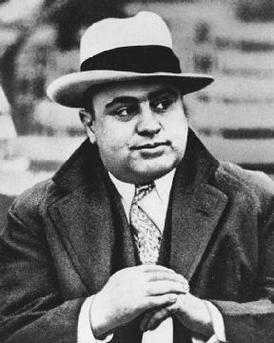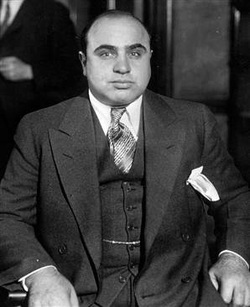Al Capone Growing up

Born January 7, 1899 (Brooklyn, New York)
Alphonse "Al" Capone was born in the Brooklyn area of New York City in January 1899. He was the fourth of nine children born to parents who had immigrated to the United States from Italy. Capone's father was a barber and his mother a seamstress. They were a hardworking family with no apparent criminal connections or tendencies. The neighborhood, however, was tough, and Capone became involved at a very early age with several youth gangs, including the Brooklyn Rippers and the Forty Thieves Juniors. When he was fourteen, Capone got into a fight with a teacher who had struck him. He dropped out of school and soon joined the Five Point Juniors, which was the youth branch of a well-known criminal organization called the Five Point Gang. Capone became a kind of apprentice to a racketeer (someone involved in illegal business activities) named Johnny Torrio (1882–1957). He ran errands for Torrio and learned from him about using cleverness, instead of violence, to get ahead.
Despite this early involvement in the city's criminal underworld, Capone also held a number of ordinary jobs, including work as a candy-store clerk and as a paper cutter in a bookbindery. He was employed as a bartender in a saloon when he received the facial marks that earned him the nickname "Scarface." He made a remark to a young woman that her brother, who was seated next to her, found insulting. The knife-wielding brother gave Capone three slashes on the left side of his face. For the rest of his life Capone was self-conscious about the scars and tried to cover them with powder.
While he was still a teenager, Capone met the young woman who would become his wife, Mary "Mae" Coughlin, who was a department-store clerk and two years older than Capone. She became pregnant and in early December 1919 gave birth to Albert Francis "Sonny" Capone. The couple married at the end of the month. Sonny, Capone's only child, later developed a serious hearing problem that may have been the result of syphilis (a sexually transmitted disease) inherited from his father. In any case, Capone loved Sonny dearly and always provided well for him.
Alphonse "Al" Capone was born in the Brooklyn area of New York City in January 1899. He was the fourth of nine children born to parents who had immigrated to the United States from Italy. Capone's father was a barber and his mother a seamstress. They were a hardworking family with no apparent criminal connections or tendencies. The neighborhood, however, was tough, and Capone became involved at a very early age with several youth gangs, including the Brooklyn Rippers and the Forty Thieves Juniors. When he was fourteen, Capone got into a fight with a teacher who had struck him. He dropped out of school and soon joined the Five Point Juniors, which was the youth branch of a well-known criminal organization called the Five Point Gang. Capone became a kind of apprentice to a racketeer (someone involved in illegal business activities) named Johnny Torrio (1882–1957). He ran errands for Torrio and learned from him about using cleverness, instead of violence, to get ahead.
Despite this early involvement in the city's criminal underworld, Capone also held a number of ordinary jobs, including work as a candy-store clerk and as a paper cutter in a bookbindery. He was employed as a bartender in a saloon when he received the facial marks that earned him the nickname "Scarface." He made a remark to a young woman that her brother, who was seated next to her, found insulting. The knife-wielding brother gave Capone three slashes on the left side of his face. For the rest of his life Capone was self-conscious about the scars and tried to cover them with powder.
While he was still a teenager, Capone met the young woman who would become his wife, Mary "Mae" Coughlin, who was a department-store clerk and two years older than Capone. She became pregnant and in early December 1919 gave birth to Albert Francis "Sonny" Capone. The couple married at the end of the month. Sonny, Capone's only child, later developed a serious hearing problem that may have been the result of syphilis (a sexually transmitted disease) inherited from his father. In any case, Capone loved Sonny dearly and always provided well for him.
Prohibition Gangsters

Capone arrived just as Prohibition was beginning. The Eighteenth Amendment, which made Prohibition official, had gone into effect in early 1920. The ban on alcohol had been brought about by reformers who wanted to protect society from the ill effects of drinking, which they felt damaged not only people's health but also their relationships and ability to work and support their families. Although some people had opposed Prohibition from the start, especially members of immigrant communities, for whom alcohol consumption had an important cultural role, most U.S. citizens supported the ban. Even Prohibition's supporters were surprised, however, when the Volstead Act (which spelled out the terms of the amendment) defined as illegal not only distilled beverages like whiskey but also fermented ones like beer and wine, which many had assumed would not be included.
Organized Crime Stats
The following are statistics detailing how much worse crime got:
- Police funding: INCREASED $11.4 Million
- Arrests for Prohibition Las Violations: INCREASED 102+%
- Arrests for Drunkenness and Disorderly Conduct: INCREASED 41%
- Arrests of Drunken Drivers: INCREASED 81%
- Thefts and Burglaries: INCREASED 9%
- Homicides, Assault, and Battery: INCREASED 13%
- Number of Federal Convicts: INCREASED 561%
- Federal Prison Population: INCREASED 366%
- Total Federal Expenditures on Penal Institutions: INCREASED 1,000%
